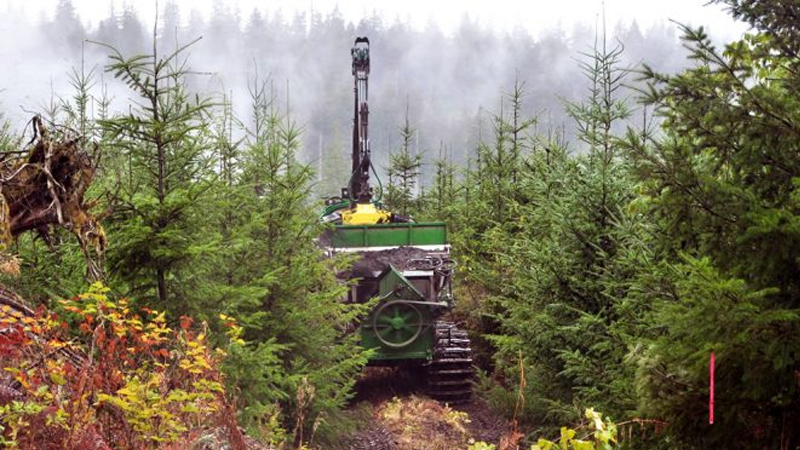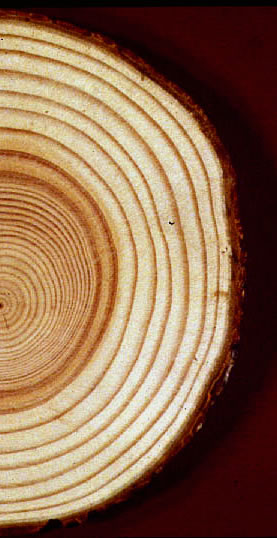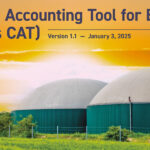 Sally Brown
Sally Brown
Tree plantations and temperate forests both rank high on the Drawdown list (#13 and #14) with high potential to store large amounts of carbon. Tree plantations on degraded land covered 294 million hectares globally in 2018 or about 726.5 million acres (1 hectare = 2.47 acres). Increasing that acreage by 112 to 174 million hectares would sequester an additional 22.2 to 35.9 gigatons (1 gigaton = 1 billion tons) of CO2 by 2050. Doing so would also mean less deforestation. The money spent to do so ($164-$260 billion) would be a distant memory when considering the profits ($2.1-$3.4 trillion). Temperate forests currently cover 1.9 billion acres. Just about all of these have been disturbed or harvested at some point in the past. Letting them regrow has created a carbon sink. Drawdown says that there is more land that could be converted to forests — 1.4 billion hectares in fact. Taking these estimated additional hectares and letting the trees grow naturally would sequester 19 to 28 gigatons of CO2 by 2050.
If you use the Drawdown temperate forest numbers and add organics you really get something to smile about. You typically don’t associate compost with forests. The primary source of recycled nutrients that most people think of when they think of forests comes from the bears that live in those forests. In fact, very little compost/biosolids/manure/digestate is used in forestry. But it turns out that when it is, you see big changes in tree productivity and soil quality. That is the case for trees in the urban jungle as well as in the forests.
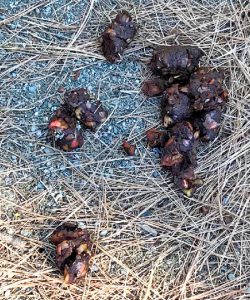
Bear scat. Photo by Chuck Henry
Biosolids In The Forests
A few local agencies use their biosolids to fertilize forest plantations. King County, Washington is one of them and is where this whole idea got going. Commercial forest plantations abound in Western Washington and applying biosolids to the forest was seen as a way to make these plantations more profitable and limit public exposure. Early applications were liquid and made at high rates. The growth response was pretty spectacular. The practice has evolved over time with lower rates now applied across the 40-year rotation (from planting to harvest) that is typical in the Pacific Northwest.
Determining forest application rates of biosolids is part of my job. Tree response, understory, soil type and drainage class are all factors I consider. A rotation will typically get between 3 to 5 applications of biosolids over the course of the 40 years.
The practice now extends into British Columbia and across to New Zealand. These tree plantations are rarely fertilized using conventional fertilizers because it is pretty hard to drive a tractor through a forest. When they are fertilized with synthetic fertilizer it is typically done by aircraft. Biosolids are applied using a side cast spreader that can throw the material over 50 meters (164 feet). Trails are cut into the trees and the spreader can apply to a 100 meter spread (little more than a football field) from a single trail. A similar approach could be used with animal manures, digestates and even composts.
Scientists have studied the practice to see if it really is beneficial. Across a number of studies and different tree species, adding biosolids to the soil makes trees grow bigger and faster. In New Zealand, with radiata pine, researchers saw an increase in growth volume of 27% to 36%. Applying biosolids over time transformed a low productivity site to a medium productivity site. This is expected to increase revenue (vis a vis tree growth) for the site by 14% to 24%. Revenue in these plantations comes from the tree trunks with the remainder of the tree generally left in place as “slash”. A different study put a dollar value of that growth increase at $130 to $247/hectare.
Similar results have been seen in Canada. Adding biosolids to trees in British Columbia doubled the tree volume for cedar and tripled it for hemlock and fir. In a different study, a single application of biosolids resulted in growth increases (measured 16-19 years after the application) ranging from 18% for a pine to 700% for oak. All of these studies also reported increases in soil carbon and nutrients, likely meaning more carbon stored in the soils below what is stored in the trees.
Site Restoration
When you talk about expanding regular forests using organics you see similar results. Andrew Trlica, a former grad student of mine, sampled restoration sites in Pennsylvania, Washington and British Columbia to measure changes in soil carbon when sites were restored with compost or biosolids — versus fertilizer or hauled in topsoil. Adding organics into the mix increased soil carbon storage by anywhere from 3 to 26 tons of CO2/hectare/year. He then used data to model how much bigger trees would get on the sites amended with organics. With conventional reclamation (no organics) in the Pacific Northwest (land of tall trees), you’d be expected to get about 183 tons/hectare of above ground CO2 storage. That sounds like a lot but realize that an old growth forest in the Pacific Northwest stores about 500 tons of CO2 in the trees. If you add organics into the mix you get closer to the old growth numbers — 275 tons of CO2 stored in above ground biomass.
Take a trip into the urban jungle and the results are pretty much the same. While urban forestry didn’t make the Drawdown list, the importance of trees in cities is clear to anyone who has ever lived in one. Trees help to curb the urban heat island, help water soak into soils, store carbon and help to maintain the sanity of the people who live in cities. It is also easy to use composts to prepare the beds for urban tree planting. Many cities offer free trees for residents. Just include a bag of compost and some planting instructions and you’re good to go. One study of tree seedlings in New York tested the benefits of planting compost with the trees. The soils with compost had 1.33 times more carbon than those without. They also had lower bulk density and happier microbes. The trees liked it too. All tree species tested got bigger faster when there was compost in the soil.
So What’s The Drawdown?
How would compost/biosolids/organics use impact the forests in Drawdown? Let’s focus on tree plantations as that is where most of the research has focused. The details in Drawdown’s temperate forest section say that each hectare of forest stores about 100 tons of CO2 — 60% in the soil and 40% in the trees. With the current 294 million hectares in plantations, we can figure that 294 million hectares x 100 tons/hectare = 29400 million tons or 29.4 billion tons of CO2 currently stored.
When biosolids are added into the mix you see tree growth increases generally well above 10%. Many of those studies also reported increased soil carbon. Andrew Trlica saw soil carbon increases well above 10%. So a 10% increase here in our calculation is certainly close enough for a ballpark estimate.
For the existing tree plantations that would mean:
- 294 million hectares x 110 tons/hectare = 32340 million tons or 32.3 billion tons of CO2
- That comes out to an extra 2.94 billion tons of CO2 (32.2-29.4 = 2.94)
If those tree plantations expanded to the low end of the Drawdown estimate that would mean an additional 112 million hectares of forest. When that reached potential storage of the enhanced CO2 per hectare (100 tons of CO2) that would mean an additional 112 million hectares x 100 tons CO2/hectare = 11200 million tons or 11.2 billion tons of CO2.
Add some compost/biosolids to that and you get:
- 112 million hectares x 110 tons CO2/hectare = 12320 million tons or 12.3 billion tons of CO2
- That is an extra 1.1 billion tons of CO2
Add biosolids to the existing plantations and expand acreage to the low end with the added fertility and you sequester an extra 4.06 billion tons of CO2. Also remember here that the Drawdown estimate for compost (based on methane avoidance from landfills) was 2.28 gigatons (billion tons) of CO2.
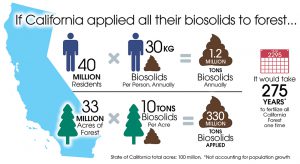 What is the hitch? Let’s use California as a test case. I’ll focus on biosolids because that is the material most commonly used for forest fertilization. California has about 40 million residents. Each person makes about 30 kg (66 lbs) of biosolids a year. Roughly about 1.2 million tons of biosolids are produced annually in California. If the biosolids were applied to forestland at 10 tons/acre that would let you get bigger and stronger trees on 120,000 acres each year. California has about 33 million acres of trees. If we figure no population increase and a constant production of biosolids, it would take 275 years’ worth of biosolids to fertilize all of the forests in California — just once.
What is the hitch? Let’s use California as a test case. I’ll focus on biosolids because that is the material most commonly used for forest fertilization. California has about 40 million residents. Each person makes about 30 kg (66 lbs) of biosolids a year. Roughly about 1.2 million tons of biosolids are produced annually in California. If the biosolids were applied to forestland at 10 tons/acre that would let you get bigger and stronger trees on 120,000 acres each year. California has about 33 million acres of trees. If we figure no population increase and a constant production of biosolids, it would take 275 years’ worth of biosolids to fertilize all of the forests in California — just once.
Forest fertilization with biosolids is a great solution — bigger trees, more carbon storage, higher profitability. If we could do this — just on existing forest plantations — we would make a huge difference. Problem is, there just isn’t enough poop to go around.


